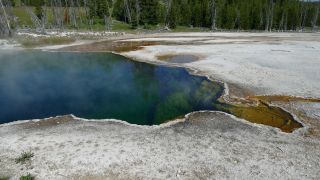A foot found floating in a hot spring at Yellowstone National Park has been linked to a July 31 death.
On Aug. 16, a park employee found the foot, still encased in a shoe, in Abyss Pool, one of the deepest hot springs in Yellowstone. In a statement today (Aug. 19), authorities said that the foot is linked to an incident involving a single individual on the morning of July 31 and that they do not suspect foul play. They did not elaborate on why they do not suspect foul play, nor did they identify the person who died. An investigation is ongoing.
Yellowstone is dotted with geothermal springs, many of which are hot enough to scald a person. Mineral crusts around the springs can appear solid but crack under the weight of someone stepping on them. In 2016, a 23-year-old Oregon man died after slipping into a scalding pool at the Norris Geyser Basin while attempting to take a dip in a closed location. The pool was over 212 degrees Fahrenheit (100 degrees Celsius) and highly acidic, according to USA Today (opens in new tab). Park officials saw the man’s body floating in the hot spring the day he died but were unable to immediately retrieve it. When they returned the next day, they could not find the remains.
“Evidence suggests that the extreme heat and the acidity of the water quickly dissolved his body in the hot spring,” according to a park report released in response to a Freedom of Information Act request filed by KULR-TV in Billings, Montana.

The pool where the Oregon man died is an acid-sulfate hot spring. These hot springs, which are found most commonly in the northeastern part of the park, are heated by acidic steam so strong that it can eat away rocks and minerals around the springs, according to the U.S. Geological Survey. Mud Volcano and Artists Paint Pots, two popular tourist sites in the park, are both acid-sulfate features.
Many of Yellowstone’s pools, however, are alkaline, or basic. The pH scale runs from zero to 14, with zero being the most acidic, 7 being neutral, and 14 being the most basic. Abyss Pool is one of the park’s alkaline pools, with a pH of 8.65, according to a paper published in the book “Mechanisms and Phylogeny of Mineralization in Biological Systems: Biomineralization ’90” (Springer Science & Business Media, 2012). A pH of 8.6 is more basic than most seawater, but less basic than baking soda. Pools like Abyss Pool get their alkalinity from fluids that carry chloride from deep below the surface.
Abyss Pool is situated in the West Thumb Geyser Basin near Yellowstone Lake. It’s up to 53 feet (16 meters) deep and is about 140 F (60 C), according to the National Park Service.
It is not clear whether the person in the spring became incapacitated by the heat of the water or died in some other way. It is not surprising, however, that it was a foot inside a shoe that revealed the occurrence of a death. Bodies left in water over time naturally decompose, and it’s common for feet to detach as the soft tissues of the feet and ankles deteriorate. Most modern shoes are buoyant, so they’ll float once set free. This phenomenon was deemed responsible for the discovery of 21 human feet (opens in new tab) that have washed ashore since 2007 in the Pacific Northwest.
Originally published on Live Science.
Hits: 0










